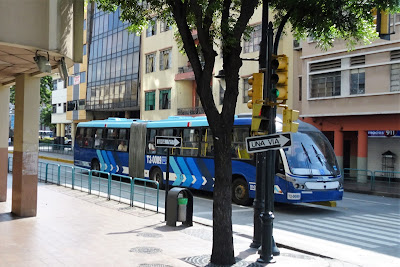Guayaquil (pronounced “why-a-keel”) is Ecuador’s largest city and its main port; while Quito is the nation’s capital city, 272 miles away and uphill into the Andes. It’s difficult to pin down exact numbers, but consensus from several sources is that the population of Guayaquil is around 3.5 million residents, while Quito’s is “over 2.6 million.” Our tour guide told us that Guayaquil is the economic capital of Ecuador, and Quito is home of the government.
Guayaquil is only 12 feet above sea level and has two seasons – the wet season (January through April) is hot and humid with heavy rainfall, and the dry season (May through December) with clouds but very little rain. We were lucky to miss the rains this year. Being close to the equator, they have nearly an exact 12 hours of sun and 12 hours of darkness every day of the year.
Believe it or not, while in Guayaquil we’re actually docked on the western bank of the Guayas River, 40 miles away from the Pacific Ocean. The Guayas River is the most important river in South America that doesn’t flow eastbound into the Atlantic Ocean. Its source is on the slopes of the Andes and Chimborazo, Ecuador's highest volcano. Water then flows westbound to the Pacific. Its total length is 240 miles. Below Guayaquil, the river flows through a low-lying delta crowded with small islands (islets) before entering the Gulf of Guayaquil. That’s how we got here overnight, cruising on this wide river.
We took a short 3-hour panoramic tour of Guayaquil at 8:15 Sunday morning. We were in a very comfortable, air-conditioned bus and had an exceptionally good tour guide named Mafy. She was very knowledgeable and proud of her home town. Most of the tour was on the bus, although we got off twice along the way. As we’ve found in many locations around the world, the area around a port is the least attractive part of a city. It was the case here as well. But, soon enough, we left the port and got into the city itself. There are many beautiful green parks we drove by. Three that were notable to us were Parque el Centenario, Parque Bolivar, and La Rotonda.
Parque Bolivar is also known as “Iguana Park.” For some reason, this park is full of Land Iguanas – 300 of them, according to Mafy. She said that this land was the Iguanas’ home before the park was installed, so they just stayed here. Anyway, the park has become a tourist attraction because of the iguanas. We got off the bus and had 15 minutes to wander around on our own.
One of the features within Malecón 2000 is La Rotonda – a large, impressive semicircle-shaped monument that Mafy pointed out while we slowly rode by. The monument commemorates a famous meeting in Guayaquil on July 26, 1822, between the two South American liberators, Simón Bolivar and José de San Martin, where they apparently discussed and strategized about the independence of all Spanish South America. Jim wasn’t able to snap a photo here, but the monument is a beautiful tribute to this historic event.
Mafy then led our bus past several more interesting areas, including the airport, the gigantic central bus terminal, a soccer stadium, and a funny Capuchin Monkey statue in the middle of the highway. She pointed out Santa Ana Hill, Guayaquil's oldest neighborhood and one of its most iconic sights. Santa Ana is a hillside district, with brightly painted homes, cafes, bars and souvenir shops, and cobblestone streets. Cannons, at the top of the hill and aimed toward the river, were once used to protect Guayaquil from pirates. Mafy said they are still fired today during celebrations.
There are a lot of modern, tall buildings on this hill, include the hotel itself and an intriguing twisty building.
- Ecuador is named after it’s location on the equator. Just outside of Quito is the “Middle of the World,” where you can stand with one foot in the northern hemisphere and the other in the southern hemisphere.
- The official currency in Ecuador has been the US Dollar since the 1990s.
- In the past there were many refugees from Colombia moving to Ecuador to escape the drug trafficking violence. That seems to have stopped, and now there are people leaving Venezuela due to their unstable economy, migrating into Ecuador.
- Crystal Symphony had to time its departure based on tides, and also to time our upcoming reserved arrival schedule at the Panama Canal on Wednesday, April 18.















No comments:
Post a Comment